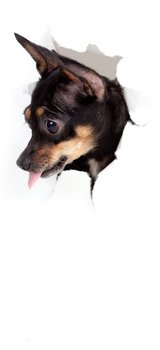Martial Arts and The Zone
On the occasions you delivered the perfect strike; blocked without the need to think or performed a near flawless kata, did it feel difficult? Or did you get the sense it happened by itself? The 'zone' is a place where athletes describe this sort of experience. Studies suggest its a state of 'effortless merging of action and awareness'. So what stops us from getting there? Factors such as stress or attempts to try harder can interfere. Often our efforts to train harder result in unnecessary muscular responses that prevent us reaching the effortless state of the zone.
How you perform a technique and how much effort you use depends on how you have done it before. The process of repeating a technique many times lays down the pattern at a subconscious level until it can be executed with minimal thought. But can you be sure that what you have learnt is the most efficient? Try these two experiments.
Experiment 1
1. Fold your arms and look to see which hand is tucked.
2. Now reverse the pattern, fold them the opposite way.
3. Notice the difference and your reaction to it.
The pattern in step 1 is your habitual 'folding the arms' programme that is activated without conscious thought and will feel familiar and comfortable. The pattern in step 2 requires some thought to achieve and will probably feel wrong, as this is different from your usual preference. This shows how strong the force of habit can be. Not only does it select the pattern of the movement in step 1 but also determines what feels right and wrong in relation to position and movement. There is nothing wrong with the pattern in step 2, but is it a move you would choose to do automatically? Probably not, because you will only perform movements that feel right. However, when you do what feels right you engage habitual movement patterns; those performed often enough to establish the habit.
Experiment 2
1. Sit on a chair and get ready to stand up.
2. Before you move, observe what preparations you want to make. Do you hold your breath? Do you push forward with the lower back and raise the chest? Do the muscles in your neck stiffen and pull back the head? Do you feel the need to push with your hands on your legs? Spend a little time to study this before attempting the next step.
3. Now try to stand up from the chair without doing what you have just noted (it may be necessary to ask someone to observe your actions to give you feedback). How far can you execute the move before one, or all of these patterns appear?
To successfully execute the last step can be difficult because the usual preparations you make are a part of your habitual 'getting out of a chair' program and are ready to go before you even begin to move. You would not attempt to start the move until the familiar conditions such as the sensation of muscle tension associated with the act are present. From a mechanical point of view the common actions mentioned in the second step actually reduce the efficiency of the movement. If your preparation and subsequent actions for this exercise are unnecessary, why do you do them?
Do the techniques of your martial art contain inefficient movements? Do they feel right because they are good or purely because they are a comfortable habit?
THE ZONE
It is my belief that our natural state is to be in the zone. Diligent practice of the martial arts can help us to experience this shift of consciousness. The zone is an altered state where things can happen with little or no perceived effort. In these moments our response appears to precede conscious thought and is executed near to perfection; right timing, right effort and entirely appropriate to the situation.
I am sure we have all experienced moments like this. For example, in one competition I scored ippon with a jodan mawashi geri to the side of my opponents exposed face. Afterwards my opponent congratulated me on my technique commenting he didn't see it coming, to which I could honestly reply, "Neither did I". I was only aware of the execution of the technique once my leg has started its recoil. Where had it come from? At some level my senses had registered the target, selected the most appropriate technique, fired it off, made the lightest of contact and started the recovery before I had become aware of it! This was probably my 'finest hour'. But how can we be capable of such remarkable feats one moment and be totally incompetent the next - I lost the next round and was appallingly slow.
Whilst the patterns (techniques) residing at a subconscious level can be called upon with incredible speed and effectiveness, I believe this can only happen if we are in a balanced state. Another word for this is poise, this is not to be confused with posture. Poise is a state of totally appropriate activity, both at a muscular and 'mental' level. When we are in this state there is 'optimum integration of the postural reflexes, consciousness and appropriate use of learnt patterns'. That is, we can get out of the way and let the processes just happen. Nerves, tension and stress will interfere with this process if we allow ourselves to react negatively to these situations such as stiffening the neck, an action that will impede the balance reflexes. Likewise, over-confidence has a similar affect of preventing the unity of self and action as, in my view, it will reduce our level of alertness and state of readiness. The ego really should be left at the door of the dojo!
So perhaps to heighten our chances of getting into the zone we need to focus on 'being in the moment'. Only by being consciously aware of the moment or 'the here and now' can we ensure inappropriate muscular activity is not present in our actions. This takes time and involves going back to some very basic movements (pre-martial art techniques) such as everyday simple activities and zazen to experience a stillness and awareness that will help in more demanding activities.
Roy Palmer is a Teacher of The Alexander Technique and author of The Performance Paradox: Train Smarter to enhance performance and reduce injury. More information can be found at http://www.artofperformance.co.uk
He works with sports people of all abilities to recognise and overcome performance-limiting habits.
|
|
|
|
|
|
|
|
|
|
|


Fairbairn on the Fairbairn Method
Something for our shooting "enthusiasts" -PRELIMINARY STATEMENTBackground:"Prior to my association... Read More
Are You Frustrated Yet?
I was talking to a parent recently and they told... Read More
Samurai Sword Basics, A Brief History
Capturing the spirit of old Japan and recognised by its... Read More
John Styers
Most people have only been exposed to John Styers work... Read More
Its Not a Matter of Who is Right
"People here may belittle sports arts...."Who?Almost EVERY "combatives" man of... Read More
Generating More Power from Hip Rotation - Lessons from Martial Arts
One of the important lessons of Martial Arts training is... Read More
Martial Arts and The Bible
As a Christian and a martial arts student, I have... Read More
The Shocking Truth About Stun Guns
If you are outside the world of law enforcement, chances... Read More
Historical References to W.E. Fairbairn, E.A. Sykes AND Dermot Pat ONeill
FROM THE BOOK: "PIERCING THE REICH" AUTHOR: JOSEPH E. PERSICOThey... Read More
Judo Nagewaza (Throwing Technique) In The Street
How practical are throwing techniques (nagewaza) for self-defense or street-fighting?... Read More
How to Relax During a Fight
I received a returned video from a well meaning, but... Read More
Break the Bones
"HONE O ORERU" is a Japanese term that translates literally... Read More
Content, Are We?
I asked a simple question at the last seminar:"How much... Read More
How To Defend Against A Knife - Dont Use The Stuff Taught In The Dojo!
Defences against Knife attacks, Firstly if at all possible get... Read More
Samurai - The Honourable & The Treacherous
The Japanese Samurai were warriors. Highly trained, skilled and efficient... Read More
British Aikido Board National Nepotism Seminar
For many years The British Aikido Board (BAB) have shown... Read More
Martial Arts Sparring and Training Protective Equipment
The benefits of Martial Arts has always appealed its practitioners.... Read More
The Thumb Jab
I'm sure a lot of you remember the scene in... Read More
I Know Karate and Kung Fu and Lots of Other Foreign Words!
Martial arts have become incredibly popular in the US. Drive... Read More
Safety Awareness & Self Defense: Circle of Safety
Safety Awareness & Self Defense is the responsibility of each... Read More
Tai-Chi for the Masses--and Others
Kuang Ping was the T'ai-chi set favored by Yang Lu-Chan,... Read More
The Best Martial Art
It is a very difficult task to determine which martial... Read More
COMBATIVES A Rose by Any Other Name?....Part 2
The advent of World War One (the war to END... Read More
Real Life Self-Defense Starts From...
"Nicky Bats" was an "old school" kinda guy. He was... Read More
Is it a ?Hurt? or is it an ?Injury?
My father fed me this line every time I felt... Read More
Strategy as Applied to Warrior-citizens
After years of study, I have come to a small... Read More
New Book: Positive Aikido
A new book with a practical look at Aikido and... Read More
The Acronym That Saved My Life
Frequently, I get asked about certifications, systems or methods. We... Read More
The Rebels Guide to Cultivating Vitality
Many Taoists recluses and Buddhists monks dwelled in mountains and... Read More
Benefits of Martial Arts Training For Kids
Admit it. When the going gets tough at home, we've... Read More
How to Select Your Martial Arts and Self Defense Equipment
The most common place to buy martial arts or self... Read More
Dermot Michael (Pat) ONeill
Dermot O'Neill was born in 1905 in County Cork, Ireland.... Read More
The Fallacy and the Myth
It's always amusing when "know it alls" dismiss certain methods... Read More


Eight Simple Rules for Saving Your Life
Let's put the non-lethal fantasy to rest.1. Never trust your... Read More
Have No Misconceptions
I just received an Email from a woman who has... Read More
Fight Simulator Theory for Reality Based Street Defense
This is such a powerful tool that it should leave... Read More
Nuts & Bolts of Self Defense
Fundamental "Nuts & Bolts" training for close combat should be... Read More
Choosing a Self Defense / Martial Arts School: A Parents Guide
"Daddy, I want to take Karate!""Mommy, Jimmy on the bus... Read More
Interesting Facts on Samurai Sword Manufacture
A samurai's sword is his most sacred and prized possession.... Read More
So You Think You Train Hard
"Tokio Hirano (1922-1993) 8th Dan The Man Who Revolutionized Judo"... Read More
Is it a ?Hurt? or is it an ?Injury?
My father fed me this line every time I felt... Read More
Who Created Tai Chi Chuan (Tai Chi Boxing)?
I have read a number of books, articles, and novels,... Read More
Things to Know About Learning Tai Chi Chuan (Tai Chi Boxing)
For Easterners, particularly Chinese, this MAY not be an issue.... Read More
Basic Drills
We all have a good foundation in the basic blows... Read More
Strategy as Applied to Warrior-citizens
After years of study, I have come to a small... Read More
Martial Arts: Mind, Body and Spirit Presented Online
This Martial Arts website uses body, spirit and mind to... Read More
The Test
"Will this work so that I can use it instinctively... Read More
The Fallacy and the Myth
It's always amusing when "know it alls" dismiss certain methods... Read More
Is Aikido a Martial Art ?
Sensei Henry Ellis Co-Author of the new book Positive Aikido.-... Read More
COMBATIVES? ...... Don?t Tell Me. I Know What That Is! (Part 1)
"Combatives" from the root word COMBAT ? "to fight in... Read More
Break the Bones
"HONE O ORERU" is a Japanese term that translates literally... Read More
Im Soooo Confused...
I was going to write about the BASICS of "practical... Read More
Martial Arts and The Bible
As a Christian and a martial arts student, I have... Read More
Martial Arts Sparring and Training Protective Equipment
The benefits of Martial Arts has always appealed its practitioners.... Read More
A Few Things Everyone Should Know to Keep Themselves Safe
The following are a few thoughts about how to decrease... Read More
COMBATIVES A Rose by Any Other Name?....Part 2
The advent of World War One (the war to END... Read More
Content, Are We?
I asked a simple question at the last seminar:"How much... Read More
Bogu Training
About four years ago Carl recommended we start using the... Read More
A Samurais Power Is In His Little Finger, Not His Samurai Sword
In the 12th Century the Shogunate was formed. The head... Read More
How To Defend Against A Knife - Dont Use The Stuff Taught In The Dojo!
Defences against Knife attacks, Firstly if at all possible get... Read More
Aikido Philosophy: An Oriental Concept of Energy, Self, and Mind
PrefaceThere are many different ways to understand Aikido philosophy and... Read More
Safety Awareness & Self Defense: Circle of Safety
Safety Awareness & Self Defense is the responsibility of each... Read More
Fronting
"Fronting": The dodge to get in close to you. The... Read More
Are You Frustrated Yet?
I was talking to a parent recently and they told... Read More
Samurai - The Honourable & The Treacherous
The Japanese Samurai were warriors. Highly trained, skilled and efficient... Read More
Benefits of Martial Arts Training For Kids
Admit it. When the going gets tough at home, we've... Read More
Martial Arts |